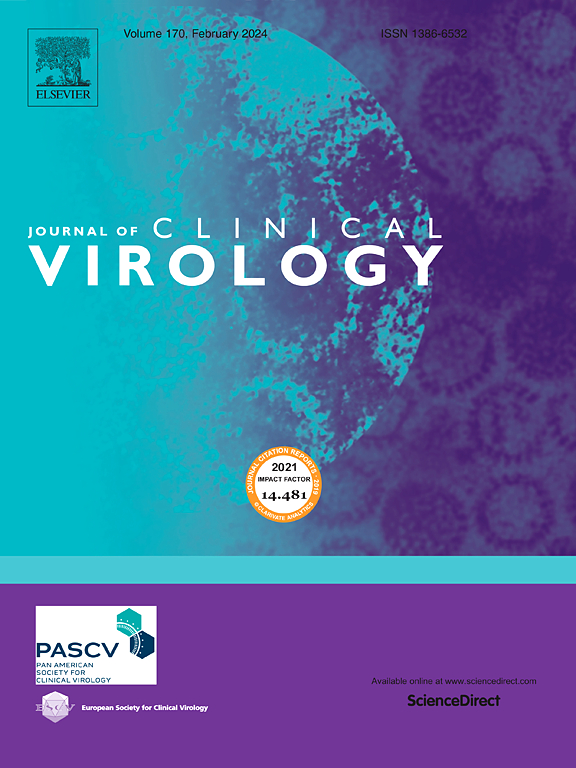Primary Epstein–Barr virus infection in preadolescent children: A prospective study
IF 3.4
3区 医学
Q2 VIROLOGY
引用次数: 0
Abstract
Importance
Epstein–Barr virus (EBV) is not only the principal cause of infectious mononucleosis (IM) but is also a precursor to several cancers and autoimmune disorders. Access to a prophylactic EBV vaccine early in life could be key for the prevention of these conditions. However, the incidence of primary EBV infection (pEBV) in preadolescent children is not currently known. We hypothesized that pEBV is clinically significant, but often undiagnosed.
Methods
In this prospective study we screened and followed preadolescent children ages 1.5–11.99 years at a single pediatric primary care clinic to determine incidence of pEBV. Using oral swabs to collect gingival crevicular fluid, we screened participants for the presence of EBV IgG antibody against viral capsid antigen. Participants who lacked EBV antibody (EBV-naïve) were enrolled in the prospective arm of the study with screening for oral EBV antibody every 3 months.
Results
Of 291 children screened, 210 (72.2 %) were EBV-naïve. Of those, 181 (86 %) were enrolled in the prospective study. During 119.8 person-years of participant observation, 11 cases of pEBV were documented. Five cases were symptomatic. The incidence of pEBV was 9.2 cases/100 person-years. Self-identified Asian, Black, and Latino children had greater incidence of pEBV relative to self-identified White children.
Conclusions
We show that the incidence of pEBV in preadolescents is higher than that of other infectious diseases with disease burdens so severe that vaccines have been used for decades to prevent their spread, but diagnosis of pEBV is often missed by parents and clinicians. This study provides a rationale to administer EBV vaccine to preadolescents. EBV is the only infectious agent assessed in the study.
青春期前儿童原发性eb病毒感染:一项前瞻性研究
eb病毒(EBV)不仅是传染性单核细胞增多症(IM)的主要病因,也是几种癌症和自身免疫性疾病的前兆。在生命早期获得预防性EBV疫苗可能是预防这些疾病的关键。然而,青春期前儿童原发性EBV感染(pEBV)的发生率目前尚不清楚。我们假设pEBV具有临床意义,但通常未被诊断。方法在这项前瞻性研究中,我们在一家儿科初级保健诊所筛选并随访年龄在1.5-11.99岁的青春期前儿童,以确定pEBV的发病率。使用口腔拭子收集牙龈沟液,我们筛选参与者是否存在针对病毒衣壳抗原的EBV IgG抗体。缺乏EBV抗体(EBV-naïve)的参与者被纳入研究的前瞻性组,每3个月进行一次口服EBV抗体筛查。结果291例患儿中,有210例(72.2 %)为EBV-naïve。其中,181人(86 %)被纳入前瞻性研究。在119.8人年的参与者观察中,记录了11例pEBV病例。5例有症状。pEBV的发病率为9.2例/100人年。自认为是亚裔、黑人和拉丁裔儿童的pEBV发病率高于自认为是白人儿童。结论:pEBV在青春期前的发病率高于其他传染病,疾病负担如此严重,以至于几十年来一直使用疫苗来预防其传播,但父母和临床医生经常错过对pEBV的诊断。本研究为在青春期前接种eb病毒疫苗提供了理论依据。EBV是该研究中唯一评估的感染因子。
本文章由计算机程序翻译,如有差异,请以英文原文为准。
求助全文
约1分钟内获得全文
求助全文
来源期刊

Journal of Clinical Virology
医学-病毒学
CiteScore
22.70
自引率
1.10%
发文量
149
审稿时长
24 days
期刊介绍:
The Journal of Clinical Virology, an esteemed international publication, serves as the official journal for both the Pan American Society for Clinical Virology and The European Society for Clinical Virology. Dedicated to advancing the understanding of human virology in clinical settings, the Journal of Clinical Virology focuses on disseminating research papers and reviews pertaining to the clinical aspects of virology. Its scope encompasses articles discussing diagnostic methodologies and virus-induced clinical conditions, with an emphasis on practicality and relevance to clinical practice.
The journal publishes on topics that include:
• new diagnostic technologies
• nucleic acid amplification and serologic testing
• targeted and metagenomic next-generation sequencing
• emerging pandemic viral threats
• respiratory viruses
• transplant viruses
• chronic viral infections
• cancer-associated viruses
• gastrointestinal viruses
• central nervous system viruses
• one health (excludes animal health)
 求助内容:
求助内容: 应助结果提醒方式:
应助结果提醒方式:


